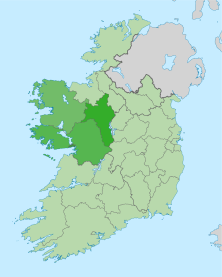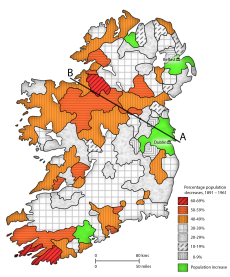👉 Find out about The Open University's Geography courses. 👈
Explore the articles in this collection
-
Change in the West of Ireland
Read now to access more details of Change in the West of IrelandIntroducing a collection of articles asking 'How can unique and distinctive regions, like the West of Ireland, retain the qualities that make them unique while continuing to modernise and interact with the wider world?'

Article
-
Synthesis as a way of understanding the changing uniqueness of rural Ireland
Take part now to access more details of Synthesis as a way of understanding the changing uniqueness of rural IrelandWhat is synthesis? Discover how this way of thinking helps us to understand more about the way in which places retain their uniqueness within wider systems of interdependence.

Activity
-
The West of Ireland: Dimensions of distinctiveness
Read now to access more details of The West of Ireland: Dimensions of distinctivenessHow do you define 'the West of Ireland'? Do you look at cultural factors, geography, or something else?

Article
-
The rural dimension – rundale in the West of Ireland
Read now to access more details of The rural dimension – rundale in the West of IrelandThe rundale system once governed how farmland was distributed between tenants in Ireland. It supposedly died out in the 19th century, but this was not actually the case in some parts of the West of Ireland.

Article
-
The rural dimension – after rundale
Watch now to access more details of The rural dimension – after rundaleHow did the rural areas of Western Ireland change after the rundale system was replaced?

Video
-
A changing uniqueness – The changing ‘place’ of the West
Read now to access more details of A changing uniqueness – The changing ‘place’ of the WestThe population of Western Ireland declined dramatically between 1891 and 1961. How do you think this affected Ireland as a whole?

Article
-
The realities of rural life in the 1950s-1980s
Watch now to access more details of The realities of rural life in the 1950s-1980sThe period of the 1950s to 1980s was the beginning of modernisation in community life and farming and the development of manufacturing industry in the West of Ireland.

Video
-
Culture and the manufacturing industry, 1983
Watch now to access more details of Culture and the manufacturing industry, 1983In 1983, the fight to retain a unique Irish speaking culture meant that jobs had to be created locally in manufacturing and tourism so that Irish speakers no longer had to emigrate, but industrialisation also threatened the survival of the Irish language.

Video
-
The dilemma of tourism and the Irish language, 1983
Watch now to access more details of The dilemma of tourism and the Irish language, 1983Father James McDyer discusses the dilemma of the Glencolmcille holiday village between development, language and culture and the threat of depopulation. Tourism is important for economic development but what impact does it have on local culture and the Irish language?

Video
-
A new layer: Culture, the Irish language and identity in 2015
Watch now to access more details of A new layer: Culture, the Irish language and identity in 2015We revisit the Glencolmcille folk village in 2015 to see whether the dilemma of development and the local language and culture has been resolved.

Video
-
Southwest Donegal: uniqueness and interdependence in 2015
Read now to access more details of Southwest Donegal: uniqueness and interdependence in 2015In Southwest Donegal, we see both the local uniqueness and different interdependencies and interconnections with other places.

Article
-
The future of rural Ireland - nuances, scale and fighting back
Read now to access more details of The future of rural Ireland - nuances, scale and fighting backThe future of rural Ireland - nuances, scale and fighting back

Article
Culture is one of the factors contributing to the distinctiveness and social coherence of a region. It consists of a whole bundle of material and non-material traits which have built up over time, including tools and implements of economic and domestic activity as well as customs, language and beliefs.
Language is often held to be a key feature of cultural identity. The speaking of Irish Gaelic, or Gaeilge, has been fostered by subsidy and exhortation since the foundation of the Irish state in 1922, but only in parts of the West has it remained an active element in the way of life. Closely associated with the language in cultural survival and revival, is the music and dancing familiar to tourists, and the strong oral tradition of songs and storytelling.
 St Brigid's Cross on the wall of a cottage in the Folk Village, Glencolmcille
There are also distinctive customs and behaviour in the West, including religious practices which blend the universalism of Catholicism with more ancient religious traditions at, for example, weddings and wakes (funerals), and in conjunction with the seasons, which were of intimate significance in a dominantly agrarian society. For example, St Brigid's day on February 1 ‘marks the beginning of the pastoral year… With many superstitious practices, more or less Christianised. The making of protective charms known as St Brigid’s crosses continues and illustrates how the Church has won over pagan symbols, for the “crosses” take the form of swastikas or lozenges which comparative evidence suggests are magical symbols of songs or eyes' (E. Estyn Evans, 1957).
St Brigid's Cross on the wall of a cottage in the Folk Village, Glencolmcille
There are also distinctive customs and behaviour in the West, including religious practices which blend the universalism of Catholicism with more ancient religious traditions at, for example, weddings and wakes (funerals), and in conjunction with the seasons, which were of intimate significance in a dominantly agrarian society. For example, St Brigid's day on February 1 ‘marks the beginning of the pastoral year… With many superstitious practices, more or less Christianised. The making of protective charms known as St Brigid’s crosses continues and illustrates how the Church has won over pagan symbols, for the “crosses” take the form of swastikas or lozenges which comparative evidence suggests are magical symbols of songs or eyes' (E. Estyn Evans, 1957).
Such survivals of a peasant society and its folk culture emphasize a sense of continuity with the past, and are important in understanding the present distinctive character of the region.
Regional distinctiveness in the West of Ireland is not just cultural. There are other combinations of elements which in turn combine with one another and with the culture to make the region distinctive. For example, the West of Ireland is also characterised as ‘rural’ and predominantly agricultural. The pastoral tradition has dominated Irish life through the ages, and local culture and society have developed in relation to this. But the pastoral economy is not simply a response to the good growth of grass: it is related to the wider economic and political concept of the relationship with Britain and Europe. For those who have exported cattle, there has often been a good living, but for a very large proportion of the population, agriculture was the sole means of subsistence, the land providing food, fuel (turf) and building materials.
Explore the articles in this collection
-
Change in the West of Ireland
Read now to access more details of Change in the West of IrelandIntroducing a collection of articles asking 'How can unique and distinctive regions, like the West of Ireland, retain the qualities that make them unique while continuing to modernise and interact with the wider world?'

Article
-
Synthesis as a way of understanding the changing uniqueness of rural Ireland
Take part now to access more details of Synthesis as a way of understanding the changing uniqueness of rural IrelandWhat is synthesis? Discover how this way of thinking helps us to understand more about the way in which places retain their uniqueness within wider systems of interdependence.

Activity
-
The West of Ireland: Dimensions of distinctiveness
Read now to access more details of The West of Ireland: Dimensions of distinctivenessHow do you define 'the West of Ireland'? Do you look at cultural factors, geography, or something else?

Article
-
The rural dimension – rundale in the West of Ireland
Read now to access more details of The rural dimension – rundale in the West of IrelandThe rundale system once governed how farmland was distributed between tenants in Ireland. It supposedly died out in the 19th century, but this was not actually the case in some parts of the West of Ireland.

Article
-
The rural dimension – after rundale
Watch now to access more details of The rural dimension – after rundaleHow did the rural areas of Western Ireland change after the rundale system was replaced?

Video
-
A changing uniqueness – The changing ‘place’ of the West
Read now to access more details of A changing uniqueness – The changing ‘place’ of the WestThe population of Western Ireland declined dramatically between 1891 and 1961. How do you think this affected Ireland as a whole?

Article
-
The realities of rural life in the 1950s-1980s
Watch now to access more details of The realities of rural life in the 1950s-1980sThe period of the 1950s to 1980s was the beginning of modernisation in community life and farming and the development of manufacturing industry in the West of Ireland.

Video
-
Culture and the manufacturing industry, 1983
Watch now to access more details of Culture and the manufacturing industry, 1983In 1983, the fight to retain a unique Irish speaking culture meant that jobs had to be created locally in manufacturing and tourism so that Irish speakers no longer had to emigrate, but industrialisation also threatened the survival of the Irish language.

Video
-
The dilemma of tourism and the Irish language, 1983
Watch now to access more details of The dilemma of tourism and the Irish language, 1983Father James McDyer discusses the dilemma of the Glencolmcille holiday village between development, language and culture and the threat of depopulation. Tourism is important for economic development but what impact does it have on local culture and the Irish language?

Video
-
A new layer: Culture, the Irish language and identity in 2015
Watch now to access more details of A new layer: Culture, the Irish language and identity in 2015We revisit the Glencolmcille folk village in 2015 to see whether the dilemma of development and the local language and culture has been resolved.

Video
-
Southwest Donegal: uniqueness and interdependence in 2015
Read now to access more details of Southwest Donegal: uniqueness and interdependence in 2015In Southwest Donegal, we see both the local uniqueness and different interdependencies and interconnections with other places.

Article
-
The future of rural Ireland - nuances, scale and fighting back
Read now to access more details of The future of rural Ireland - nuances, scale and fighting backThe future of rural Ireland - nuances, scale and fighting back

Article
Rate and Review
Rate this article
Review this article
Log into OpenLearn to leave reviews and join in the conversation.
Article reviews